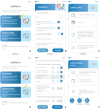A mobile app to improve adherence to colorectal cancer screening and post polypectomy surveillance guidelines
- PMID: 40148816
- PMCID: PMC11948656
- DOI: 10.1186/s12876-025-03796-0
A mobile app to improve adherence to colorectal cancer screening and post polypectomy surveillance guidelines
Abstract
Background: Despite significant advances in prevention and early detection, colorectal cancer (CRC) is a leading cause of cancer mortality worldwide. Inadequate adherence and/or lack of knowledge of guidelines have shown to prevent adequate screening and surveillance recommendations and hinder effective screening programs.
Objective: Evaluate the implementation and real-world impact of a mobile app designed to optimize CRC screening and surveillance in accordance to recently updated guidelines.
Methods: A mobile app including ergonomic algorithms integrating all pertinent guideline information was created by a group of experts. Data were collected from Catalonia healthcare professionals using the app between February 2023 and May 2024. Users' characteristics, consultation types, and patient data were analyzed to assess app's implementation, usage patterns, and impact on CRC screening and surveillance outcomes.
Results: A total of 12,481 consultations were recorded; 3,054 (24.4%) screening and 9,427 (75.6%) post-polypectomy surveillance consultations. The app was increasingly and repeatedly used by professionals during the study period (72% retention rate). Among screening consultations, 2,082 (68.2%) patients were classified as average risk, suggesting the use of fecal occult blood test (FOBT) instead of colonoscopy. Among surveillance consultations, the app advised deferring follow-up colonoscopies and using FOBT instead in 4,748 (50%) patients based on negative index colonoscopy or the presence of low-risk polyps. Standard surveillance with colonoscopy at 3 years was recommended for 3,224 (34.1%) patients and intensive surveillance, requiring a colonoscopy at 1 year, was indicated for 749 (7.9%) patients.
Conclusions: A CRC screening and surveillance mobile app showed remarkable acceptance and uptake among healthcare professionals. Proper implementation of updated guidelines aided by the use of the app could significantly reduce the number of unnecessary screening and post-polypectomy surveillance colonoscopies, as well as help identifying high risk patients who require intensive surveillance.
Clinical trial: Not applicable.
Keywords: Colon cancer; Colorectal cancer; Mobile app; Prevention programs; Screening.
© 2025. The Author(s).
Conflict of interest statement
Declarations. Ethics approval and consent to participate: Waived due to retrospective nature and deidentified information. Consent for publication: No. Competing interests: The authors declare no competing interests.
Figures




References
-
- Ferlay J, Shin HR, Bray F, Forman D, Mathers C, Parkin DM. Estimates of world- wide burden of cancer in 2008: GLOBOCAN 2008. Int J Cancer. 2010;127:2893–917. - PubMed
-
- Cheng L, Eng C, Nieman LZ, et al. Trends in colorectal cancer incidence by anatomic site and disease stage in the united States from 1976 to 2005. Am J Clin Oncol. 2011;34:573–80. - PubMed
-
- Adami H-O, Kalager M, Valdimarsdottir U, Bretthauer M, Ioannidis JPA. Time to abandon early detection cancer screen- Ing. Eur J Clin Invest. 2019;49:e13062. - PubMed
-
- Lin JS, Piper MA, Perdue LA, et al. Screening for colorectal cancer: updated evidence report and systematic review for the US preventive services task force. JAMA. 2016;315:2576–94. - PubMed
MeSH terms
LinkOut - more resources
Full Text Sources
Medical

